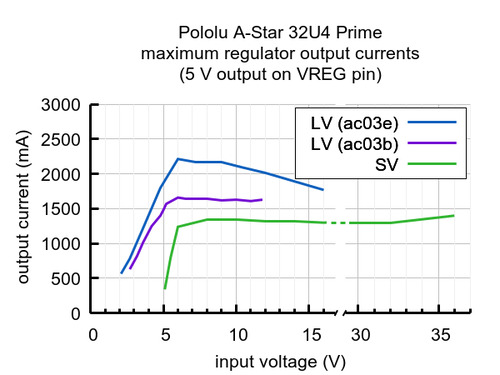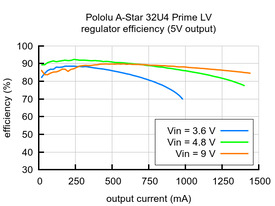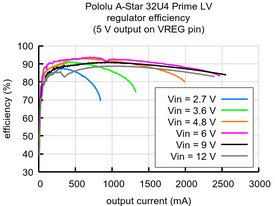Support » Pololu A-Star 32U4 User’s Guide » 5. A-Star 32U4 Prime »
5.3. A-Star 32U4 Prime LV regulator
There have been two versions of the A-Star 32U4 Prime LV: the original ac03b version and its replacement, the newer ac03e version. The ac03e version uses an improved 5 V regulator that can deliver more current (1.8 A vs 1.5 A) and operates from 2 V to 16 V instead of 2.7 V to 11.8 V. The easiest way to distinguish between the two versions is via the silkscreen on the bottom side of the board, above and to the left of the Pololu logo, where the original version is labeled ac03b and the new version is labeled ac03e. See the picture below for a side-by-side comparison:
 |
A-Star 32U4 Prime LV: comparison of original ac03b version (left) to newer ac03e version (right). |
|---|
The A-Star 32U4 Prime LV (ac03b) is the original version of the Prime LV, and it can be powered from a 2.7 V to 11.8 V external source. The input voltage is regulated to 5 V by a 1.5 A TPS63061 switching step-up step-down (buck-boost) converter from Texas Instruments. (We also make a standalone regulator based on this integrated circuit.)
The A-Star 32U4 Prime LV (ac03e) is the newest version of the Prime LV, and it can be powered from a 2 V to 16 V external source (though it requires at least 3 V at start-up). The input voltage is regulated to 5 V by a 1.8 A TPS630701 switching step-up step-down (buck-boost) converter from Texas Instruments. (We also make a standalone regulator based on this integrated circuit.)
For both versions of the Prime LV, the regulators’ flexibility in input voltage is especially well-suited for battery-powered applications in which the battery voltage begins above 5 V and drops below 5 V as the battery discharges. Without the typical restriction on the battery voltage staying above 5 V throughout its life, a wider range of battery types can be considered. For example:
- A 4-cell battery holder, which might have a 6 V output with fresh alkalines or a 4.0 V output with partially discharged NiMH cells, can be used to power this A*.
- A disposable 9 V battery powering the board can be discharged to under 3 V instead of cutting out at 6 V, as with typical linear or step-down regulators.
The graphs below show the efficiency of the two LV versions, where efficiency is defined as (Power out)/(Power in):
|
|
The A-Star’s components, including the microcontroller and LEDs, draw 30 mA to 40 mA in typical applications. The rest of the regulator’s achievable output current, which depends on input voltage as well as ambient conditions, can be used to power other devices. Maximum ouput currents for both versions of the A-Star Prime LVs are shown in the graph below. These currents are close to the limits of the regulators’ capabilities and generally cannot be sustained for long periods; under typical operating conditions, a safe limit for the maximum continuous regulator output current is approximately 1.5 A for ac03b and 1.8 A for ac03e.
 |
Note that the startup current for the regulator on the A-Star 32U4 Prime LV (ac03e) is limited to approximately 700 mA, and currents in excess of this are only available after the output has finished rising to 5 V.

























